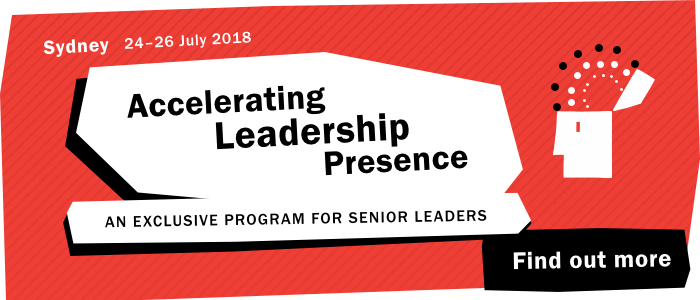20th June 2018
Authentic Leadership 101: Becoming a ‘Second Circle’ Leader
Can something from the world of Performing Arts make you a more authentic and capable leader? We think so, and we’re borrowing a concept called ‘The Second Circle’ to frame authentic leadership – and how you should think about your verbal communication as a leader.
We want to recommend a great book, The Second Circle, written by renowned voice coach and director, Patsy Rodenburg. Some books are important; this is certainly one of them. Rodenburg has the gift of synthesis. Her book is a must read if you want to truly grasp why ‘presence’ and authentic leadership characteristics are so important in business…and in life.
Most people want to be more present with their leadership, but a smaller percentage prevail. To use Rodenburg’s language, those who are present are in “second circle.” The book also reinforces why authenticity is critical to your success as a leader. It is virtually impossible to be an authentic leader unless you are in the second circle.
Which circle are you in?
To put ‘second circle’ in perspective, picture three circles lined up horizontally. The one in the middle is second circle. To the left of middle is first circle. To the right is third circle.
Rodenburg writes that you are always in one of these three circles at any given time – in any energy exchange with other people, especially on a team. The circles are always in play and will have major impact on a team dynamic.
In first circle, you are largely connected inward, into yourself – where it is difficult for anyone to connect with you. Picture the image of a turtle going into its shell.
You can feel disconnected from a person who has gone into first circle. It’s like they are in the room with you, but not really. If you personally spend a lot of time in first circle, people will find it difficult to engage with you. They often stop trying.
In third circle, you are largely connected outward. Your energy may come across as forceful, maybe even rigid and locked down – where it is also difficult for people to connect with you. Picture the image of a blowfish under attack.
You can immediately feel disconnected from a person who goes into third circle. It’s like they cannot listen; their ears stop working. If you spend a lot of time in third circle, it can be a very lonely place. People find it difficult to engage with a blowfish.
Trust and authentic leadership
Rodenburg masterfully unpacks second circle as an energy exchange based on the ‘give and take’ required for real trust. There is a reciprocity in the exchange, where you are both giving and receiving. She describes intimacy as only possible in second circle, where genuine trust begins in any relationship.
In second circle, you don’t feel the need to be perfect; you just feel the need to get the best outcome. There is a certain mentality that enables you to sit comfortably in second circle. Ego, status and pride don’t interfere with your ability to hear and learn in second circle. You are really comfortable with who you are – and who you aren’t.
A talented friend, who plays in a jazz quartet, believes they perform best when they’re in second circle. When they are most intuitive with each other, they can feel an immediate connection with the audience – because it’s about what the audience needs. When it is not about ego or pride, they can all focus on what the audience needs. That is the essence of Rodenburg’s second circle.
The new orange: leading change
People who struggle with change will spend a lot of time in first or third circle. It’s the classic ‘fight or flight’ response caught in over-drive, especially given how quickly the change cycles are moving these days. If you hate change, the pace in today’s business world will be doing your head in.
Brene Brown uses the term ‘wholehearted’ to describe people who are comfortable with vulnerability. I believe that ‘second circle’ captures that very same zone of the wholehearted – where you are confident enough to be open to the best ideas. This is the very essence of what people describe when they talk about an authentic person.
We all know that change is only going to keep happening faster, so it’s time to take the true value of EQ to the next level. If we believe that ‘change agility’ is the new orange, then let’s start to build strategies to move more of our leaders into second circle.
Whether you call it second circle or authenticity, it certainly seems to be the defining point for leadership success. Leadership is ultimately in the connection. I encourage you to read Rodenburg’s book.
Or better still, think about attending our Accelerating Leadership Presence program on July 24-26 in Sydney. Enrolments are open now. We teach the Second Circle in the program, and our Performing Arts coach on the program is an expert in applying the Second Circle concept in the context of Leadership.
Categories: Developing Leaders





